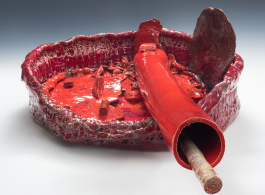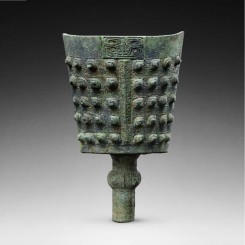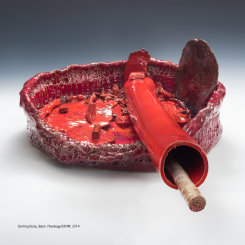Thursday, 26th November 2015–Saturday, 9th January 2016 Opening reception: Thursday, 26th November, from 6:00 to 8:00pm
In collaboration with Gisèle Croës Arts d’Extrême-Orient, Gagosian Hong Kong is pleased to present “The Shape of Time,” an exhibition of exceptional Asian antiques and modern and contemporary works by Georg Baselitz, Cai Guo-Qiang, Chu Teh-Chun, Alberto Giacometti, Andreas Gursky, Liu Dan,Takashi Murakami, Nam June Paik, Richard Serra, and Zao Wou-Ki.
Among the exquisite objects that Gisèle Croës has selected for the exhibition are Longshan culture black pottery (3rd millennium BCE); a crown headdress with glass ornaments from the Tang dynasty (618-907 CE); a gilt bronze mask from the Liao dynasty (916-1125 CE); and a carved wooden Bodhisattva figure (twelfth or thirteenth century CE). Of special interest to Croës are bronze vessels–symbols of dynastic power that for centuries played an essential role in ceremonies connecting the living and the dead–and there are key examples from the Shang, Zhou, and Han dynasties.
These rare artefacts are presented alongside modern and contemporary paintings, drawings, sculptures, and photographs that revisit historically persistent subjects and common formal concerns. A bronze Ding vessel (770-481 BCE) is shown beside Cai Guo-Qiang’s A Certain Lunar Eclipse:
Project for Humankind No. 2 (1991), made by exploding gunpowder to produce epic celestial forms across a seven-panel screen measuring six meters in width. In new two-part ink and wash drawings, Georg Baselitz pairs reconsidered motifs from his own oeuvre with iterations of a
nineteenth century self-portrait by ukiyo-e artist Katsushika Hokusai.
In Untitled (1958), Chu Teh-Chun conflates the Chinese landscape painting tradition with the free spirit of Art Informel and Western abstraction; while in Bangkok III (2013), Andreas Gursky depicts the Chao Phraya as a dark, reflective flow, conjuring a lineage of painterly depictions of water, from the cascading riverbanks of Song dynasty landscape paintings to Claude Monet’s Nymphéas. Upon closer observation, man-made pollution in the water suggests that Gursky’s sublime image is very much in and of its time.
The title of the exhibition alludes to George Kubler’s groundbreaking book of 1962 that challenged the
notion of style by placing the history of objects and images in a larger continuum whereby processes
of innovation, replication, and mutation are in continuous dialogue. Spanning millennia, the works are
integrated without chronological mandate so that the viewer can discover fresh and unexpected
correspondences between past and present.



